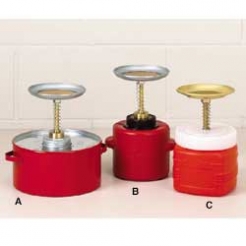Flammability is always a potential safety hazard. With the increase in the use of non-water based chemicals comes an ever growing exposure to these flammable or combustible materials. Precautions can be taken to prevent the possible outbreak of fire by storing these chemicals with flammable safety products such as flammable safety cabinets, combustible safety waste cans, floor standing rinse tanks, plunger cans and safety cans to name a few.
Using General Industry as a reference from OSHA, the definition of a flammable liquid is having a flash-point below 100° Fahrenheit or 37.8° Celsius. The exception is any mixture having 99% or more make up which consists of having a flash-point equal to or higher than the aforementioned degrees listed. There are currently three classes of flammable liquids:
- Class 1A – Liquids that have a flash-point under 73° Fahrenheit or 22.8° Celsius with a boiling point lower than 100° Fahrenheit or 37.8° Celsius.
- Class 1B – Liquids that have a flash-point under 73° Fahrenheit or 22.8° Celsius with a boiling point equal to or higher than 100° Fahrenheit or 37.8° Celsius.
- Class 1C – Liquids that have a flash-point equal to or higher than 73° Fahrenheit or 22.8° Celsius with a boiling point lower than 100° Fahrenheit or 37.8° Celsius.
- Class 2 – Liquids have flash-points equal to or higher than 100° Fahrenheit or 37.8° Celsius and lower than 140° Fahrenheit or 60° Celsius. The exception is any mixture with a make up of 99% or higher with flash-points equal to of higher than 200° Fahrenheit or 93.3° Celsius.
- Class 3 – Liquids which have a flash-point equal to or higher than of 140° Fahrenheit or 60° Celsius. Class 3 combustible liquids are divided into two classes.
– Class 3B – Liquids with flash-points equal to or higher than 200° Fahrenheit or 93.3° 200° Fahrenheit or 93.3° Celsius, except a mixture made up of 99% or higher of components with flash-points of 200° Fahrenheit or 93.3° Celsius or higher.

As stated earlier. These figures are merely for reference. Before handling, storing, or using flammables or combustibles it is your responsibility to do the homework. Get the proper literature from the proper sources prior. Get the proper literature from International Code Council (ICC), The National Fire Protection Agency (NFPA) for your proper guide lines and Occupational Safety and Health Administration (OSHA) in regards to safety for flammables and combustible liquids.
